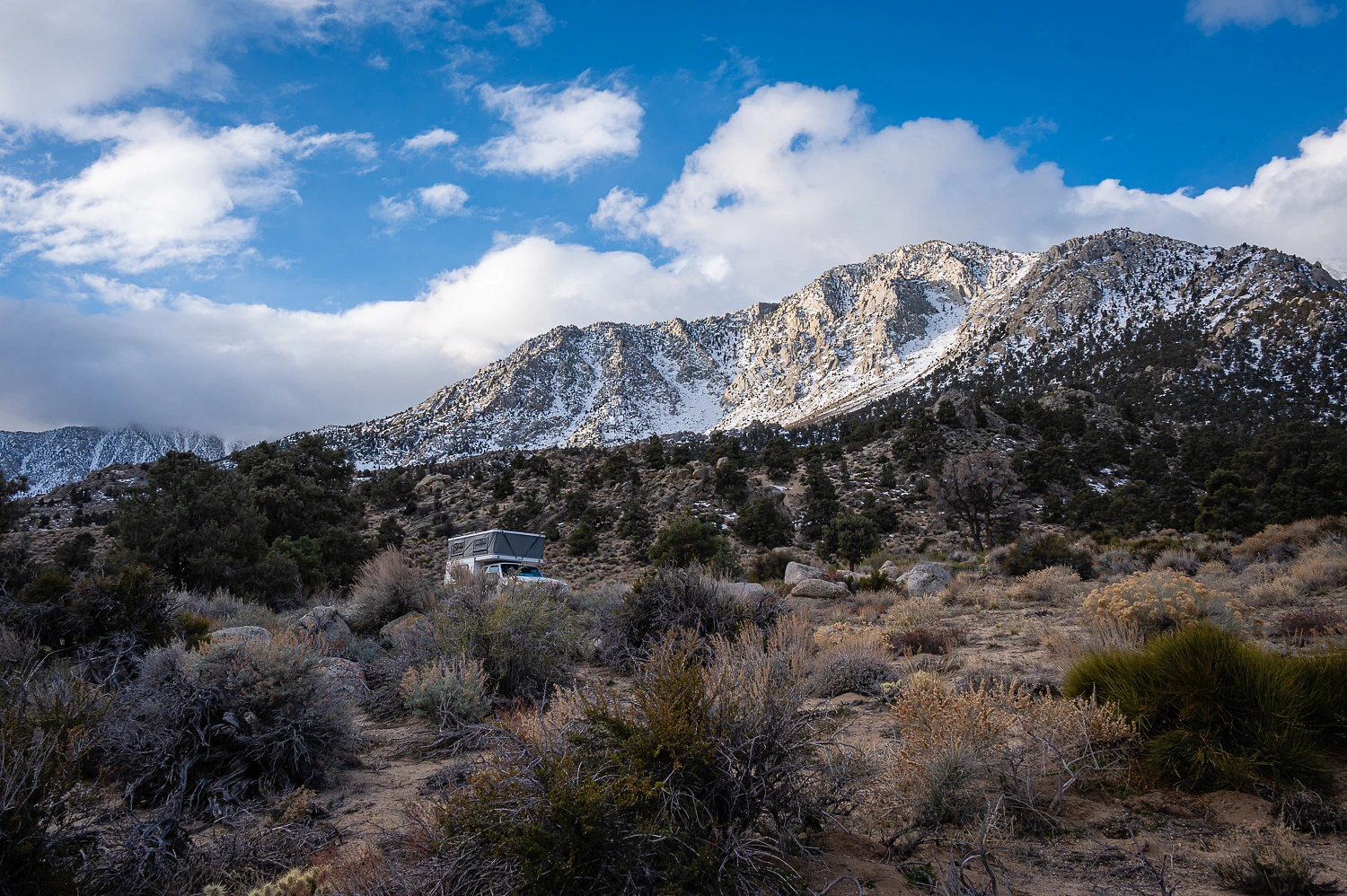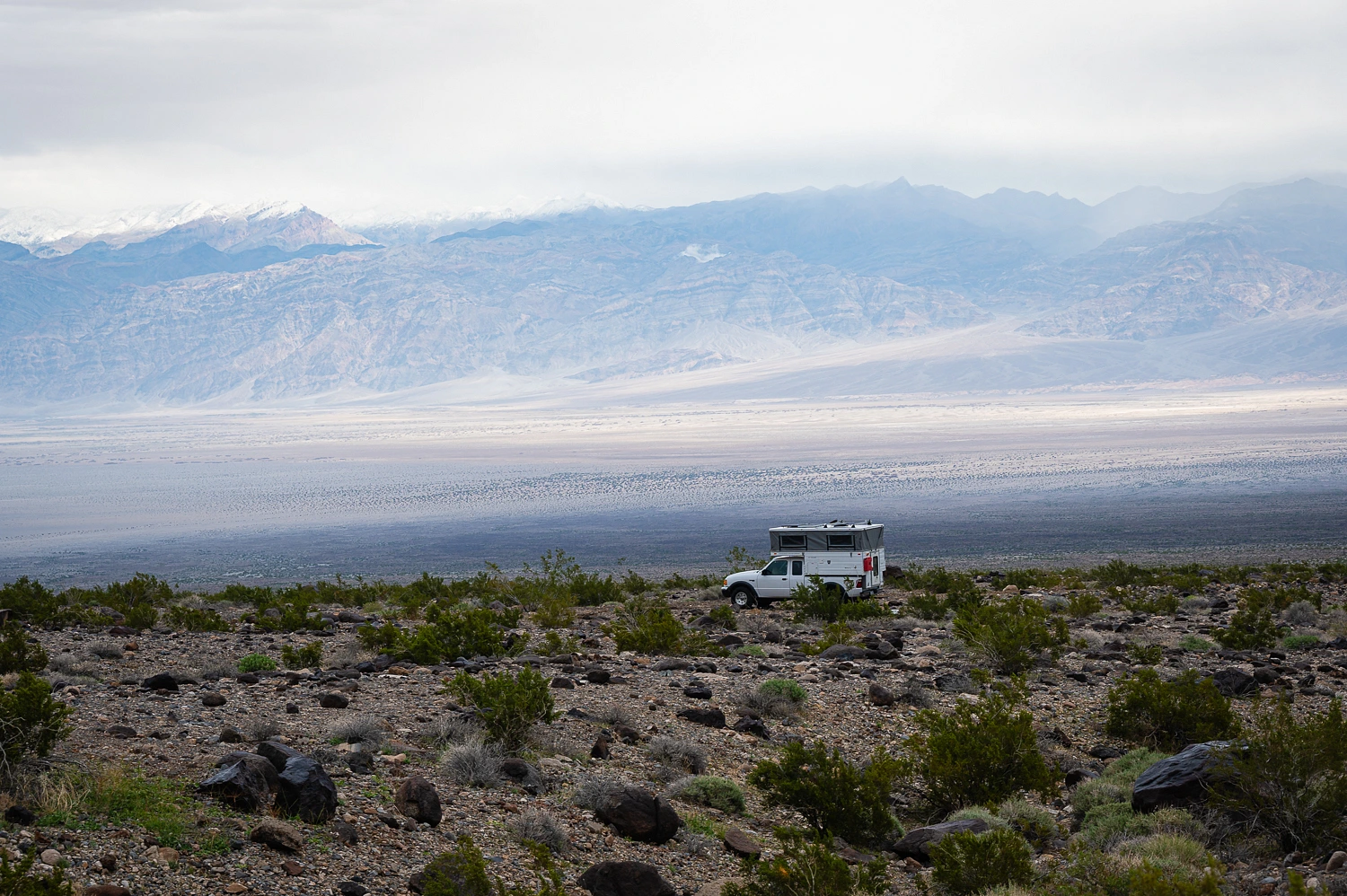please remember you can click on a photo to see a larger size & highlighted text are links to additional information
Ghosts
It was early Saturday morning. We were awake but still up in our bunk watching the day beginning to brighten outside. The loud furious drumming began at 0630. The source was an encampment a quarter of a mile away but it sounded like it was right outside our camper. Fifteen minutes later it started up again with renewed fervor, calling the pilgrims together and then sending them forth, out into the wilderness, to transform into tarp people.
But I’m ahead of myself. This story begins Wednesday morning when we started our drive south. By mid afternoon we were back in hot water, as our friend The Sagebrush Reconnoiterer likes to say. Julie, the “Tub Whisperer” had scored once again, finding an opening at Benton just the day before.
Besides the restorative healing waters, Benton is convenient. It is a part day drive for us and offers a warm refuge in an area where overnight temperatures can drop into the single digits. And thus is a pretty darn nice spot for the first night on a trip heading further south.
We topped off with groceries in Mammoth and then took a look at “the list.” We had time. Could a quick search be successful?
Snow, big sage, pinyon, and juniper – a near perfect combination.
And dramatic vistas.
And a successful search.
We made another stop at an old corral.
This winter we’ve been pretty successful at fitting trips in between storms here at home. This was our last snow clean up.
The storm was clearing Wednesday morning but chain controls were still in effect on most roads. Thursday morning at Benton, we were surprised that, after a mostly clear night, swirling clouds were back. The storm had dropped south into the Great Basin with cloud cover and storm now coming in from the east.
We still received short bursts of sunlight as we walked about Benton in the early morning.
Heading south on highway 395, the wind grew in intensity. Approaching Lone Pine, we saw that the Owens Lake Basin was obscured with blowing dust. We did not want to cross through there in these conditions so we decided to search for an overnight spot that was sheltered, at least somewhat, from the wind. We headed up into the mouth of Tuttle Creek Canyon and were rewarded. To the east clouds were coming over the Inyo Mountains. Veils of virga swept over Lone Pine and the Alabama Hills.
Clouds also enshrouded the Sierra crest behind us.
Storm was coming. We bundled up with our rain gear and hiked up the south side of the canyon into the John Muir Wilderness before the hard snow and ice became too treacherous to continue. We returned to camp, found a crossing of Tuttle Creek far below us, and hiked up the north side of the canyon into the Wilderness. We earned our dinner. Rain, snow, and wind drove us into the camper just as we finished eating outside.
We were up in the bunk, dropping off into peaceful slumber, when we first heard the dog barking, even over the sound of the wind that rocked the camper. It was a ways away but sounded much closer than the nearest homestead below us.
As we woke in the morning, the Lady asked, “Did you hear the man hollering last night? I heard him holler, twice, coming from the same direction as the dog barking, to the north.”
I had not heard him.
As the Lady fussed and made coffee, I wandered about outside and joyfully took in the drama of clouds still gripping the jagged Sierra. Shafts of first light added to the show.
“Where do you want to walk this morning?” I asked when the Lady climbed out of the camper with our coffee mugs.
“Across the creek and look for where the dog barking and man hollering was coming from.”
We looked back at the truck as we dropped down into the gorge to cross the creek.
We spent around an hour and a half looking. We climbed to high points where the Lady put her see mores to work. We found no evidence of any kind of camp. We looked at a couple of old buildings at a developed spring site. Nothing. About a mile away, tucked up against the flank of the mountains, were old ruins. That is what we thought until we got closer. Now (with the see mores) it appeared to be a partially built structure that had been abandoned before completion. The dog barked in the distance.
“Perhaps a squatter and his dog has found shelter and is making use of that place.” I told the Lady. “There is no sign of any kind of vehicle in the area.”
“Probably,” the Lady replied. “But I still think it could have been a ghost in the night.”
On our last trip to Death Valley we wanted to return to LeMoigne Canyon Road but we found it closed due to recent flood damage. This time the barricades were gone so we turned onto the rough dirt road and headed up toward the mouth of LeMoigne Canyon. Driving up, from a distance we saw two vehicles parked at the area before the road drops into the wash. We were in no way ready for what we found when we reached that point – three more vehicles were parked below in the wash and a city of tents set up. What the hell?
We backtracked down the road and found a suitable spot we could level up the truck and be comfortable. We were a quarter mile from the visible vehicles above the wash. Two ravens joined us to supervise our set up. They made themselves comfortable atop the berm on the opposite side of the road as we worked. With camp was set up, the rain began.
It rained hard through the afternoon. Taking advantage of a short break in the rain, we wandered after dinner. Not wanting to go through the encampment, we crossed the main large wash to the north and climbed up on the bajada beyond. We know this area very well. We began to find newly stacked rock cairns and strips of brightly colored bandanas tied to creosote bushes. We found two separate new caches of four supermarket one-gallon containers of water.
“Oh my god,” the Lady quietly said. “Could it be them again?”
Rain pelted the camper roof all night long. In the morning (Saturday now) our coffee mugs were ready shortly after the reverberating echoes of the drumming faded away. We walked cross country to the south to intersect the historic trail that moves along the mountain front. We reached a nice highpoint with a view just as the rain began anew. An arrangement of colored rocks was placed on top of a flat boulder. A folded note was inside a baggy. From the outside it read, “Please do not move. March 2024.”
“I have to know what this is,” the Lady said as she carefully unfolded the paper. “It’s some kind of spiritual message. I’m putting it back.”
We also found two more water caches.
Walking back, we encountered two women with backpacks coming from the encampment, walking separately and apart. One stopped at the first water cache and removed her backpack. The second continued in our direction, her head down, passed within feet of us, and pretended we were not there.
“It is them, I bet!” the Lady said at a whisper. “They’ve taken a vow of silence.”
We returned to camp. The rain subsided around 1000 hrs. so we put on our boots and packs and headed back out the historic trail to the south.
The ground was dark from the rain. The air felt heavy and wet. The first woman had completed setting up her tarp at a water cache. She was only a few feet off the trail. The second woman, further out, had her bright red tarp deployed. It was set up right along the trail. Underneath, gear was laid out. She had a thermarest pad and a thick sleeping bag which she was in. A mop of hair was visible. She was lying within six feet of the trail and our path.
“I’m curious,” I said to the Lady as we passed, “I wonder if Old Cap’ LeMoigne’s ghost walks his old trail at night?”
“He used this trail?” she asked.
“Yes, this was his route in and out of the canyon and his place up the South Fork. The current road was put in by others after his death in Death Valley. As much as he loved this place, I expect he’d want to continue walking these trails.”
We ended up exploring into a canyon, following old paths, climbing highpoints for views, and made a large circle that took us back to camp around 1600 hrs. On the way we found two more tarps set up just feet off the old historic (well worn and visible) trail and two more set up in the wash along the road that leads to the trailhead and Wilderness boundary.
“There’s tarp people everywhere,” the Lady observed.
“Tarp people?”
“Yes, tarp people. That’s what I call them.”
I should note that when we passed by the red tarp with the woman underneath on our return, the Lady pointed a stern finger at me and said, “Now, when we go by this time do not say a thing.”
The wildflowers stopped us many times.
I especially wanted to check out the two Desert Guide Posts that were placed along the old trail in 1906 by Inyo County and funded by an appropriation by the California Legislature in 1905. Most have been vandalized and the signs stolen over the many years since their erection.
Here’s what the intact “Cottonwood 12 Miles” guide post looked like in Dec 2015 with the original sign still in place.
We also checked on two other archeological treasures that are close to our hearts.
Roods Rock with its 1849 inscription – hard to read with it rain soaked.
And the old wagon.
Returning to camp, with a loop to the north around the encampment and vehicles, we came upon additional tarp people we did our best to avoid.
After chores, clean up, and dinner we again crossed the big wash and wandered until dark. The evening was quiet – oh thank you, thank you! – and we took in the day’s end.
Rain started up as soon as we crawled up into our bunk for the night. Although it was a comforting, peaceful sound, I found it difficult to fall asleep.
“I don’t know if I can fall asleep,” I told the Lady, warm and snug beside me. “I’m so curious, do you think the tarp people are allowed to cry out if Jesus appears?”
Our adventure continues. Please click here for - Part Two







































